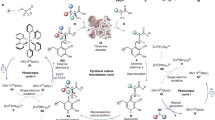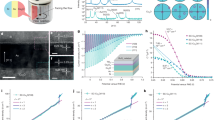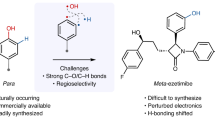Abstract
Across chemical disciplines, an interest in developing artificial water splitting to O2 and H2, driven by sunlight, has been motivated by the need for practical and environmentally friendly power generation without the consumption of fossil fuels. The central issue in light-driven water splitting is the efficiency of the water oxidation, which in the best-known catalysts falls short of the desired level by approximately two orders of magnitude. Here, we show that it is possible to close that ‘two orders of magnitude’ gap with a rationally designed molecular catalyst [Ru(bda)(isoq)2] (H2bda = 2,2′-bipyridine-6,6′-dicarboxylic acid; isoq = isoquinoline). This speeds up the water oxidation to an unprecedentedly high reaction rate with a turnover frequency of >300 s−1. This value is, for the first time, moderately comparable with the reaction rate of 100–400 s−1 of the oxygen-evolving complex of photosystem II in vivo.
This is a preview of subscription content, access via your institution
Access options
Subscribe to this journal
Receive 12 print issues and online access
$259.00 per year
only $21.58 per issue
Buy this article
- Purchase on Springer Link
- Instant access to full article PDF
Prices may be subject to local taxes which are calculated during checkout





Similar content being viewed by others
References
Alstrum-Acevedo, J. H., Brennaman, M. K. & Meyer, T. J. Chemical approaches to artificial photosynthesis. 2. Inorg. Chem. 44, 6802–6827 (2005).
Sun, L., Hammarström, L., Åkermark, B. & Styring, S. Towards artificial photosynthesis: ruthenium–manganese chemistry for energy production. Chem. Soc. Rev. 30, 36–49 (2001).
Gust, D., Moore, T. A. & Moore, A. L. Solar fuels via artificial photosynthesis. Acc. Chem. Res. 42, 1890–1898 (2009).
Sala, X., Romero, I., Rodríguez, M., Escriche, L. & Llobet, A. Molecular catalysts that oxidize water to dioxygen. Angew. Chem. Int. Ed. 48, 2842–2852 (2009).
Umena, Y., Kawakami, K., Shen, J-R. & Kamiya, N. Crystal structure of oxygen-evolving photosystem II at a resolution of 1.9 Å. Nature 473, 55–60 (2011).
Dismukes, G. C. et al. Development of bioinspired Mn4O4-cubane water oxidation catalysts: lessons from photosynthesis. Acc. Chem. Res. 42, 1935–1943 (2009).
Romain, S., Vigara, L. & Llobet, A. Oxygen–oxygen bond formation pathways promoted by ruthenium complexes. Acc. Chem. Res. 42, 1944–1953 (2009).
Dau, H. et al. The mechanism of water oxidation: from electrolysis via homogeneous to biological catalysis. ChemCatChem 2, 724–761 (2010).
Meyer, T. J. Chemical approaches to artificial photosynthesis. Acc. Chem. Res. 22, 163–170 (1989).
McDaniel, N. D., Coughlin, F. J., Tinker, L. L. & Bernhard, S. Cyclometalated iridium(III) aquo complexes: efficient and tunable catalysts for the homogeneous oxidation of water. J. Am. Chem. Soc. 130, 210–217 (2008).
Hull, J. F. et al. Highly active and robust Cp* iridium complexes for catalytic water oxidation. J. Am. Chem. Soc. 131, 8730–8731 (2009).
Lalrempuia, R., McDaniel, N. D., Müller-Bunz, H., Bernhard, S. & Albrecht, M. Water oxidation catalyzed by strong carbene-type donor–ligand complexes of iridium. Angew. Chem. Int. Ed. 49, 9765–9768 (2010).
Mullins, C. S. & Pecoraro, V. L. Reflections on small molecule manganese models that seek to mimic photosynthetic water oxidation chemistry. Coord. Chem. Rev. 252, 416–443 (2008).
Wasylenko, D. J., Ganesamoorthy, C., Borau-Garcia, J. & Berlinguette, C. P. Electrochemical evidence for catalytic water oxidation mediated by a high-valent cobalt complex. Chem. Commun. 47, 4249–4251 (2011).
Dogutan, D. K., McGuire, R. & Nocera, D. G. Electocatalytic water oxidation by cobalt(III) hangman β-octafluoro corroles. J. Am. Chem. Soc. 133, 9178–9180 (2011).
Yin, Q. et al. A fast soluble carbon-free molecular water oxidation catalyst based on abundant metals. Science 328, 342–345 (2010).
Ellis, W. C., McDaniel, N. D., Bernhard, S. & Collins, T. J. Fast water oxidation using iron. J. Am. Chem. Soc. 132, 10990–10991 (2010).
Fillol, J. L. et al. Efficient water oxidation catalysts based on readily available iron coordination complexes. Nature Chem. 3, 807–813 (2011).
Gersten, S. W., Samuels, G. J. & Meyer, T. J. Catalytic oxidation of water by an oxo-bridged ruthenium dimer. J. Am. Chem. Soc. 104, 4029–4030 (1982).
Duan, L., Fischer, A., Xu, Y. & Sun, L. Isolated seven-coordinate Ru(IV) dimer complex with [HOHOH]− bridging ligand as an intermediate for catalytic water oxidation. J. Am. Chem. Soc. 131, 10397–10399 (2009).
Nyhlén, J., Duan, L., Åkermark, B., Sun, L. & Privalov, T. Evolution of O2 in a seven-coordinate RuIV dimer complex with a [HOHOH]−1 bridge: a computational study. Angew. Chem. Int. Ed. 49, 1773–1777 (2010).
Xu, Y. et al. Chemical and light-driven oxidation of water catalyzed by an efficient dinuclear ruthenium complex. Angew. Chem. Int. Ed. 49, 8934–8937 (2010).
Bozoglian, F. et al. The Ru-Hbpp water oxidation catalyst. J. Am. Chem. Soc. 131, 15176–15187 (2009).
Cooper, V. R. et al. Stacking interactions and the twist of DNA. J. Am. Chem. Soc. 130, 1304–1308 (2007).
Sarkhel, S., Rich, A. & Egli, M. Water-nucleobase ‘stacking’: H–π and lone pair–π interactions in the atomic resolution crystal structure of an RNA pseudoknot. J. Am. Chem. Soc. 125, 8998–8999 (2003).
Acknowledgements
This work was supported by the Swedish Research Council, K & A Wallenberg Foundation, the Swedish Energy Agency, the China Scholarship Council (CSC), the China Natural Science Foundation (21120102036), the National Basic Research Program of China (2009CB220009), MICINN (CTQ2010-21497 and Consolider Ingenio 2010 CSD2006-0003) Spain and the WCU Program (R31-10010) Korea.
Author information
Authors and Affiliations
Contributions
L.S. and A.L. supervised the project. T.P. supervised the theoretical part of the project. L.D. synthesized all the complexes and carried out the characterization, catalysis and electrochemistry. S.M. carried out the electrochemistry and mass measurements. F.B. performed stopped-flow UV–vis measurements. B.S. and T.P. performed DFT calculations. L.S., A.L., L.D. and T.P. wrote the paper.
Corresponding authors
Ethics declarations
Competing interests
The authors declare no competing financial interests.
Supplementary information
Supplementary information
Supplementary information (PDF 1685 kb)
Rights and permissions
About this article
Cite this article
Duan, L., Bozoglian, F., Mandal, S. et al. A molecular ruthenium catalyst with water-oxidation activity comparable to that of photosystem II. Nature Chem 4, 418–423 (2012). https://doi.org/10.1038/nchem.1301
Received:
Accepted:
Published:
Issue Date:
DOI: https://doi.org/10.1038/nchem.1301
This article is cited by
-
Covalent triazine frameworks with Ru molecular catalyst for efficient photocatalytic oxygen evolution reaction
Science China Materials (2024)
-
Engineering the axial coordination of cobalt single atom catalysts for efficient photocatalytic hydrogen evolution
Nano Research (2024)
-
Magnesium single-atom catalysts with superbasicity
Science China Chemistry (2023)
-
Biomimetic active sites on monolayered metal–organic frameworks for artificial photosynthesis
Nature Catalysis (2022)
-
Enzyme-like water preorganization in a synthetic molecular cleft for homogeneous water oxidation catalysis
Nature Catalysis (2022)




